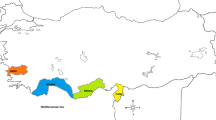Abstract
Investigation of four safflower ( Carthamus tinctorius L.) cultivars (S208, S400, S541 and S303) showed that when the seeds were harvested at different stages of growth and development (10, 20, 30, and 40 days) after flowering, moisture content significantly decreased with time. Oil, protein, ash and crude fiber were increased up to day 30. Thereafter, these parameters started to decline gradually with time. The cultivars differed in their final values; oil content of the seeds varied from 10.90 to 45.40%, moisture varied from 4.20 to 8.10% and from 8.50 to 11.10%, protein from 12.10 to 20.30% and from 13.40 to 29.60%, ash from 2.30 to 5.40% and from 2.80 to 6.50%, for the seeds and defatted meal, respectively. Crude fiber for the defatted meal was found to vary from 29.50 to 38.60%. Carbohydrate for all cultivars decreased rapidly up to day 40 with final values varying from 28.10 to 63.30% and from 56.70 to 70.30% for the seeds and defatted meal, respectively. Mineral content (Cu, Zn, Fe, Mg, Mn) fluctuated while phosphorus content significantly increased with time for all cultivars. Amino acid content of the defatted meal increased with time up to day 30 after which it started to decline gradually for all cultivars.
Similar content being viewed by others
References
Anonymous (1974) Western Hemisphere Nutrition Congress IV. Nutrition Today 9: 28–32.
Knowles PF (1975) Recent research on safflower, sunflower and cotton. J Am Oil Chem Soc 52: 374–376.
Betschart AA (1975) Factors influencing the extractability of safflower protein (Carthamus tinctoriusL.). J Food Sci 40: 1010–1013.
Betschart AA, Fong RY, Hanamoto MM (1979) Safflower protein isolates: Functional properties in simple systems and breads. J Food Sci 44: 1022–1026.
Latha TS, Prakash V (1984) Studies on the protein from safflower seed (Carthamus tinctoriusL.). J Agric Food Chem 32: 1412–1416.
Lyon CK, Gumbmann MR, Betschart AA, Robbins DJ, Saunder RM (1979) Removal of bitter and cathartic components from safflower meal. J Am Oil Chem Soc 56: 560–563.
Palter R, Lundin RE, Haddon WF (1972) A cathartic lignan glycoside isolated from Carthamus tinctorius. Phytochemistry 11: 2871–2874.
AOAC (1980) Official Methods of Analysis, 13th ed. Washington, DC: Association Official Analytical Chemists.
Pico Tag Amino Acid Analysis System (1986) Operator manual, Waters chromatography division publications PB 34 Maple street, Manual No. 88140.
Analysis and Quality Control for Fruit and Vegetable Products (1986) 2nd ed. Tata McGraw Hill Publishing Co. New Delhi, India.
Sendecor GW, Cochran WG (1987) Statistical methods, 7th edn. the Iowa State University Press, Ames IA: 221–222.
Duncan BD (1955) Multiple range and multiple F-tests. Biometrics 11: 1–42.
Cuggloz DD, Herring VV, Palter R, Kohler GO (1968) Composition of several types of safflower seed. J Am Oil Chem Soc 45: 689–693.
Author information
Authors and Affiliations
Rights and permissions
About this article
Cite this article
Rahamatalla, A.B., Babiker, E.E., Krishna, A.G. et al. Changes in chemical composition, minerals and amino acids during seed growth and development of four safflower cultivars. Plant Foods Hum Nutr 52, 161–170 (1998). https://doi.org/10.1023/A:1008022400221
Issue Date:
DOI: https://doi.org/10.1023/A:1008022400221



